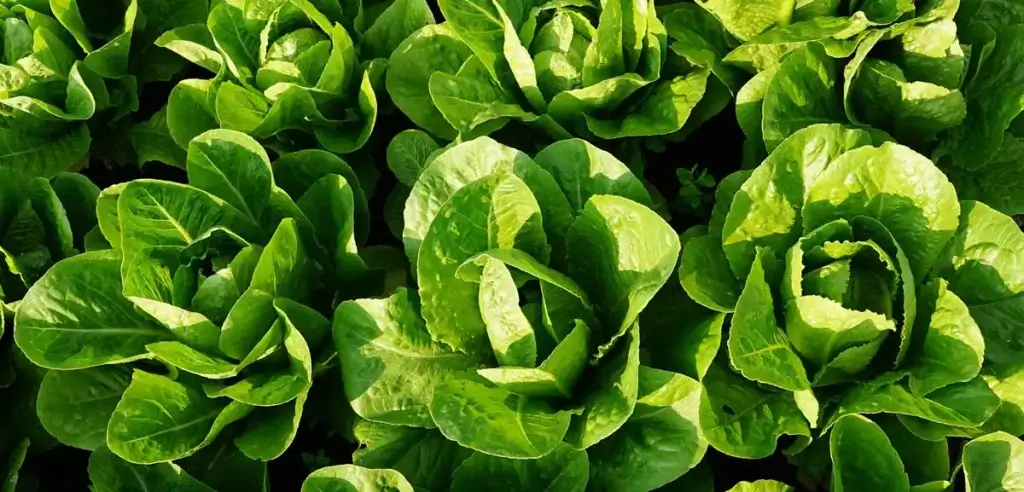How the health benefits of Lettuce Can Improve Your Overall Health
Do you know the health benefits of lettuce? This leafy green vegetable is a powerhouse when it comes to nutrition. Lettuce is low in calories and high in fiber, making it the perfect food for those who are trying to lose weight or maintain a healthy lifestyle. Lettuce is also a good source of vitamins and minerals, including vitamin A, vitamin C, potassium and magnesium. In this comprehensive guide, we will discuss the benefits of lettuce and its nutritional value. So read on to learn more about this amazing vegetable!
What Is lettuce?
Lettuce has a mild taste and is known for its high water content, making it a refreshing addition to any meal. It is also a valuable source of vitamins A and K, as well as folate and iron. Lettuce leaves can range in color from dark green to red to pale green, with some varieties featuring a mix of colors. While iceberg lettuce is often the most readily available in supermarkets, there are dozens of varieties worth exploring, including romaine, butter lettuce, and red leaf lettuce. Whether eaten raw or cooked, lettuce offers versatile options for enhancing any dish. Its nutritional benefits make it a worthwhile addition to any diet.
Tell me the history of lettuce?
Lettuce has a long history of cultivation and use, with ancient Egyptian farmers extracting oil from its seeds and Medieval writers describing it as a medicine. It was brought to America by European settlers in the 15th century, and by the 18th and 19th centuries there were multiple known varieties. Today, lettuce is popular for both its crunchy texture in salads and sandwiches, and its health benefits such as being high in vitamin K and containing antioxidant properties. Whether enjoyed raw or cooked, lettuce’s long history in food culture shows no signs of slowing down.

Types of lettuce
When it comes to lettuce, there are numerous varieties to choose from.
- Romaine, also known as cos, has long crunchy leaves with a slightly bitter taste.
- Butterhead lettuce features soft, tender leaves with a mild flavor.
- Iceberg lettuce is most commonly found in grocery stores and has a crisp texture and mild flavor.
- Green Leaf lettuce comes in a range of colors, shapes, and flavors, including red and green oakleaf, lollo rossa, and arugula.
- Romanesco is unique in its spiral-shaped heads and nutty taste.
- Finally, looseleaf lettuce includes varieties such as red and green buttercrunch and lolla bionda, which have tender leaves that can be mixed together for salads or used as individual wraps.
No matter the type of lettuce chosen, it’s a healthy addition to any meal.
Lettuce Nutrition Facts
When it comes to leafy green vegetables, lettuce may not stand out as a nutritional powerhouse. However, this crisp salad staple boasts a range of health benefits. Lettuce is low in calories and contains fiber to support digestion and heart health. It is also a good source of vitamin A, which aids in vision and immune function, and vitamin K, which helps with blood clotting and bone health. In addition, lettuce has a high water content, making it a great choice for hydration. So the next time you’re assembling a salad or sandwich, don’t underestimate the power of lettuce. Add some crispy leaves for extra nutrients and crunch. Your body will thank you.
100 grams of romaine lettuce contain the following nutrients:
- 20 calories
- 7 grams carbohydrates
- 3.4 grams fat
- 1.24 grams protein
- 1.8 grams fiber
- 4.6 milligrams Vitamin C (150% of RDI)
- 102 micrograms Vitamin K (118% of RDI)
- 436 milligrams Vitamin Α (31% of RDI)
- 50 micrograms Vitamin B9 – folate (27% of RDI)
- 0.078 milligrams Vitamin B6 (14% of RDI)
- 0.145 milligrams Vitamin B5 – pantothenic acid (12% of RDI)
- 253 milligrams potassium (10% of RDI)
- 0.127 milligrams manganese (10% of RDI)
- 30 milligrams phosphorus (10% of RDI)
- 0.14 milligrams vitamin E (10% of RDI)
- 0.95 milligrams iron (8% of RDI for men, 4% of RDI for women)
- 0.072 milligrams Vitamin B2 – riboflavin (8% of RDI)
- 13.7 milligrams magnesium (7% of RDI)
- 0.05 milligrams copper (7% of RDI)
- 0.25 milligrams zinc (5% of RDI)
- 0.08 milligram Vitamin B1 – thiamin (5% of RDI)
- 0.32 milligrams Vitamin B3 – niacin (4% of RDI)
- 35 milligrams calcium (3% of RDI)
- 41 milligrams Sodium (3% of RDI)
- 0.4 micrograms Selenium (3% of RDI)
- 5230 micrograms Carotene, beta
Health Benefits of lettuce
Lettuce is often overlooked as a nutritious leafy green, but research shows that it can offer a range of health benefits. With high levels of Vitamin C and antioxidants, lettuce can help to boost immunity and fight inflammation. It may also promote heart health, improve bone strength, and aid in preventing sleep disturbances and digestive difficulties.
In addition, lettuce contains high levels of water and fiber, making it a low-calorie choice for weight loss and reducing the risk of diabetes. Studies have even shown that lettuce may have cancer-fighting properties and a positive impact on brain and vision health. Lettuce’s hydrating qualities may also benefit skin and hair health, while its iron content can help with anemia and muscle strength. Adding lettuce to your daily diet may do more than just add variety – it could truly improve your overall well-being.
1. May help with weight loss
When trying to lose weight, many people focus on cutting calories and increasing exercise. However, micronutrient deficiencies can also inhibit weight loss efforts. That’s where lettuce can come in. With a low calorie content and high water and fiber content, adding lettuce to your meals can provide important nutrients without significantly increasing your caloric intake. Darker varieties like romaine contain even more nutrients. Plus, the fiber in lettuce can help you feel fuller and may decrease the temptation to overeat. While more research is needed on its specific effects on weight loss, incorporating lettuce into your diet can only have positive benefits.
2. May reduce diabetes risk
Some researchers suggest that consuming these types of vegetables can decrease the symptoms of type 2 diabetes and improve overall health outcomes. This may be attributed to their low calorie and cholesterol content, as well as notable levels of micronutrients. Lettuce also contains lactucaxanthin, an antioxidant carotenoid that has been found to lower glucose levels and potentially aid in the management of diabetes. Incorporating lettuce and other green leafy vegetables into your diet is a simple yet effective step towards promoting better blood sugar control and overall well-being.
3. May Fight Inflammation
Certain proteins found in romaine lettuce, such as lipoxygenase, reduce swelling. This was shown in Iran studies. A new study shows lettuce is a popular herbal remedy that helps treat inflammation and osteodynia (swollen bones). The Vitamin A & B in lettuce are helpful in decreasing inflammation. You can normally add two cups of raw salad greens to your diet regularly. Other vitamin K-rich vegetables include cabbage, kale, and radishes. It is more anti-oxidant and more efficient to combat inflammation. Lettuce has also been referred to as pain-resistant foods.
4. May Boost Heart Health
The nutrients in romaine lettuce may have a positive impact on heart health. Specifically, the high amount of folate present in romaine helps to convert homocysteine, a compound that can damage blood vessels and lead to plaque buildup in the heart. In addition, romaine provides vitamin C and potassium, both of which have been shown to improve cardiovascular function and reduce risk for heart disease. Incorporating two cups of romaine lettuce into your daily diet could potentially offer significant benefits for heart health.
5. May improve bone health
In addition to being a tasty component in salads and sandwiches, lettuce also offers important nutritional benefits for bone health. Vitamins K, A, and C all play important roles in the formation of collagen, a protein found in bone tissue. Vitamin K is particularly beneficial during pregnancy, as it helps strengthen cartilage. Also, helps the body absorb and utilize calcium, which is essential for strong bones. Research suggests that vitamin K intake can prevent osteoporosis, increase bone density and decrease the risk of fractures and osteopenia.
In addition, vitamin A helps promote the growth of new bone cells, making it an essential component in preventing the development of osteoporosis and reducing the risk of fractures. And vitamin C helps to prevent bone depletion in older individuals. Incorporating lettuce into your diet can help ensure that you are getting enough of these crucial vitamins for strong bones.
6. May Promote Brain Health
Lettuce may also support brain health through the regulation of cellular death and improved endothelial function, lettuce extract has been found to have a positive impact on neurological health. Lettuce is also high in nitrates, which are converted into nitric oxide in the body and aid in carrying important signals throughout the cells. These functions can potentially prevent or delay cognitive decline and neurodegenerative diseases commonly associated with aging.
7. May Promote Vision Health
The presence of vitamin A, vitamin C, and carotenoids like zeaxanthin has been linked to a reduced risk of various eye disorders. These include conditions such as corneal thickening, cataracts, glaucoma, and age-related macular degeneration.
Beta-carotene, a form of vitamin A found in plants, has specifically been shown to play a role in preventing macular degeneration. It is worth noting that these benefits can only be achieved by obtaining these nutrients through diet or supplementation; consuming romaine lettuce alone will not definitively protect against these eye disorders.
8. May Help Fight Cancer
In addition to being a delicious addition to salads and sandwiches, romaine lettuce may also have cancer fighting properties. Studies have shown that the chlorophyll pigment found in dark leafy greens like romaine lettuce can help reduce the risk of certain cancers, including colon and liver cancer.
Romaine also contains antioxidants like vitamin A and vitamin C, which have been linked to a decreased risk for various types of cancer. So not only is eating romaine lettuce a tasty choice, it may also be a beneficial component of your overall cancer prevention strategy.
9. May Improve Skin And Hair Health
The benefits of lettuce extend beyond just being a nutritious green for our salads. Including lettuce in your diet may lead to improved skin and hair health. Vitamin A encourages the regeneration of new skin cells, while vitamin C acts as a shield against sun damage and slows down the aging process.
The dietary fiber found in lettuce can also support proper detoxification, leading to improved skin conditions. In fact, studies have shown that using lettuce extracts on the face can improve facial health. And anecdotally, some have even reported that rinsing hair with lettuce juice may lead to stronger strands.
10. May be good for pregnancy
When it comes to prenatal nutrition, folate is a vital component. This essential nutrient helps to prevent certain birth defects, and finding appropriate sources is crucial for expectant mothers. Lettuce, particularly dark leafy varieties like romaine, arugula, and spinach, is an excellent source of folate. In addition, lettuce also contains vitamin K which aids in blood clotting and bone health during pregnancy. While all vegetables are important for overall nutritional balance, incorporating lettuce into your diet can provide additional benefits for pregnant women.
11. May Fight Anemia
Lettuce is rich in folate, a vitamin that plays a crucial role in red blood cell development and function. A deficiency in folate can lead to megaloblastic anemia, characterized by underdeveloped red blood cells. While folate deficiencies can occur naturally, they are also often the result of overexposure to certain chemicals and can even contribute to autoimmune diseases. By incorporating lettuce into your diet, you can maintain adequate levels of folate and potentially avoid these health concerns. So not only is lettuce a delicious addition to any meal, it may also protect against anemia.
12. May Help Treat Insomnia
Along with getting enough exercise and limiting screen time before bed, maintaining a healthy diet can also improve sleep quality. Lettuce contains an ingredient called lactucarium, which has been found to stimulate nerves and promote sleep. In fact, during Medieval times it was commonly used as a natural remedy for insomnia.
So next time you’re having trouble falling asleep, consider adding some lettuce leaves to your salad or creating a soothing bedtime tea with lettuce infusion. And don’t forget about other sleep-promoting vegetables like broccoli and cabbage, which also contain lactucarium. So give lettuce a try for improved slumber and sweet dreams.
13. May Promote Digestive Health
Lettuce is a great choice for promoting digestive health. Rich in fibers, lettuce helps to move food through the digestive tract, reducing the likelihood of indigestion and bloating. Eating lettuce with other foods can also aid in their digestion, leading to more comfortable digestion overall. These benefits make lettuce a valuable addition to any meal – not just for its taste, but for its positive effects on digestive health.
14. May keep you hydrated
As we all know, maintaining proper hydration is crucial for our overall health and wellness. While many turn to beverages like water and juice to stay hydrated, it may surprise you to know that certain fruits and vegetables can also contribute to our daily water intake. Among these hydrating foods is lettuce, which is made up of 85% water by weight.
In addition to providing hydration, incorporating lettuce into your diet has numerous benefits such as promoting digestive health and providing essential vitamins and minerals. So the next time you feel thirsty, consider reaching for a crisp leafy green salad instead of another glass of water.
15. May Boost Immunity
In addition to its role as a nutrient-dense leafy green, romaine lettuce may also have immune-boosting benefits. Rich in vitamins A and C, romaine lettuce can help regulate gene expression related to autoimmune issues, fight infections, reduce inflammation, protect skin, and support proper absorption of nutrients.
These impacts on the immune system make romaine lettuce a valuable addition to any well-rounded diet. So next time you’re looking for a healthy salad topping or sandwich component, consider reaching for some romaine lettuce. Your immune system will thank you.
When it’s best?
Although it can be grown year-round in the right conditions, there are certain times of the year that are considered peak season for this leafy green. In general, spring and fall tend to be the best times to plant and harvest lettuce. The cool temperatures during these seasons allow for slow, steady growth that results in tender, crisp leaves.
Additionally, planting in spring and fall allows for a longer growing season with minimal risk of heat or cold damage. Of course, lettuce can still be enjoyed out of season through hydroponic or indoor growing methods. However, for those looking for the freshest, most flavorful lettuce possible, planting and harvesting during the cool seasons is the way to go.
What to look for when buying lettuce?
When purchasing lettuce, there are a few key factors to consider. Firstly, make sure to examine the leaves for any signs of wilting or browning. These defects can affect the taste and texture of the lettuce. Secondly, check for any visible damage or bruises, as these can also detract from the overall quality of the lettuce.
Additionally, check that the packaging is intact and not torn or punctured, as this could signal potential contamination. Lastly, pay attention to the sell-by date to ensure that you are buying a fresh product. By considering these factors, you can be confident in buying high-quality lettuce for your next meal.
How to store lettuce?
When it comes to storing this leafy vegetable, the key is moisture control. First, wash and dry the lettuce thoroughly before storing. Then, wrap the lettuce in paper towel and place in a resealable plastic bag or container with small holes for ventilation. The paper towel will help absorb excess moisture, preventing wilting and mold growth.
Lettuce can be stored in the refrigerator for several days to prolong its freshness. However, for best results consume within 1-2 days of purchasing or harvesting. For longer storage, consider blanching and freezing the lettuce for use in soups, stews, and stir-fries throughout the year. You can also preserve lettuce by pickling or fermenting for added flavor and extended shelf life. Overall, proper storage techniques can greatly extend the shelf life of your lettuce and ensure a fresh, crisp flavor when it comes time to eat.
Preparing lettuce
When it comes to preparing lettuce, the first step is to wash it thoroughly before use. This can be done by submerging the leaves in a bowl of cold water and swishing them around to remove any dirt or debris. Once washed, lettuce can be used as is for a salad, or it can be dried with a salad spinner or towel before adding dressing.
It can also be cut into thin strips for use in sandwiches or wraps. For more flavorful options, lettuce can be grilled or sautéed before being added to a dish. No matter how you choose to prepare it, lettuce adds a crisp and refreshing addition to any meal. Just remember to always make sure it’s clean before consuming it.
How to use lettuce(Recipes)
Lettuce has a wide variety in its consumption and has been part of many cultures’ food. Raw fresh lettuce is commonly used on sandwiches, salads, rolls, and salads. Lettuce is also good with garden berries and berries, and also makes great use of fresh seafood such as crabs and shrimp as a starter. Lettuce is surely an energy-boosting and healthy food for the body.
Grilled Romaine Lettuce with Blue Cheese:
Ingredients:
– 1 head romaine lettuce, leaves removed
– 2 tablespoons olive oil
– 1/4 cup blue cheese dressing
– 1/4 cup crumbled blue cheese
– Salt and pepper, to taste
Instructions:
1. Preheat the grill to medium-high heat.
2. In a large bowl, combine romaine lettuce leaves, olive oil, blue cheese dressing, and crumbled blue cheese. Season with salt and pepper, to taste.
3. Grill lettuce for 2-3 minutes per side, or until slightly charred around the edges. Serve immediately.
Creamy Caesar Salad:

Ingredients:
– 1/2 cup Caesar dressing
– 1/4 cup grated Parmesan cheese
– 1/2 teaspoon garlic powder
– Salt and pepper, to taste
– 2 cups chopped romaine lettuce
– 1/4 cup croutons
Instructions:
1. In a small bowl, whisk together Caesar dressing, Parmesan cheese, garlic powder, salt, and pepper, to taste.
2. In a large bowl, combine chopped romaine lettuce and croutons. Pour dressing over top and toss to coat. Serve immediately.
Thai Lettuce Wraps:

Ingredients:
– 1/2 pound ground chicken or pork
– 1/4 cup diced red onion
– 1/4 cup diced green bell pepper
– 2 tablespoons soy sauce
– 1 tablespoon rice vinegar
– 1 teaspoon honey
– 1/4 teaspoon ground ginger
– Salt and pepper, to taste
– 8 lettuce leaves, for wrapping
Instructions:
1. In a large skillet over medium heat, cook ground chicken or pork until browned. Drain any excess fat.
2. Add red onion, green bell pepper, soy sauce, rice vinegar, honey, ground ginger, salt, and pepper to the skillet. Cook until vegetables are tender, about 5 minutes.
3. Spoon mixture into lettuce leaves and roll up tightly. Serve immediately.
Bacon and Egg Salad Lettuce Cups:
Ingredients:
– 1/2 cup mayonnaise
– 2 tablespoons diced celery
– 2 tablespoons diced red onion
– 1 tablespoon diced green bell pepper
– 1/4 cup crumbled bacon
– 2 hard boiled eggs, chopped
– Salt and pepper, to taste
Instructions:
1. In a medium bowl, whisk together mayonnaise, celery, red onion, green bell pepper, bacon, and chopped eggs. Season with salt and pepper, to taste.
2. Spoon mixture into lettuce leaves and roll up tightly.
Easy Garden Fresh Tomato Soup:
Ingredients:
– 2 tablespoons olive oil
– 1/2 cup diced onion
– 1/4 cup diced celery
– 1/4 cup diced green bell pepper
– 2 cloves garlic, minced
– 1 (14.5 ounce) can diced tomatoes, undrained
– 1 (6 ounce) can tomato paste
– 2 cups chicken broth
– 1 teaspoon sugar
– 1/4 teaspoon dried thyme
– Salt and pepper, to taste
Instructions:
1. Heat olive oil in a large saucepan over medium heat. Add onion, celery, green bell pepper, and garlic. Cook until vegetables are tender, about 5 minutes.
2. Stir in diced tomatoes, tomato paste, chicken broth, sugar, thyme, salt, and pepper. Bring to a simmer and cook for 10 minutes. Serve immediately.
Risks and Side Effects
While lettuce is a healthy and nutritious addition to any diet, it is important to be aware of the potential risks associated with consuming it. It is crucial to thoroughly wash all lettuce before consumption, especially if it has been pre-cut or packaged. Any signs of wilting or discoloration should also be a red flag that the lettuce may not be safe to eat.
In addition, make sure to properly store your lettuce in the refrigerator and consume it within a reasonable timeframe for optimal safety. If you suspect that you have gotten sick from contaminated lettuce, it is recommended to seek medical attention and report the illness to your local health department. Eating a balanced diet with a variety of fruits and vegetables can provide numerous health benefits, but it is imperative to take necessary precautions when consuming potentially risky foods such as lettuce.
Final Thoughts
As a culminating conclusion, it’s evident that lettuce is not only a delicious addition to any salad or sandwich, but it also offers numerous health benefits. Lettuce provides a significant amount of vitamins and minerals, including folate, Vitamins A, C, and K, and potassium. Its high water content makes it a low-calorie and refreshing choice, while its fiber content can aid in digestion and weight management. Overall, incorporating lettuce into your daily diet can be a simple way to support your overall health and well-being. So go ahead – pile on the lettuce at your next meal!
The health benefits of wheatgrass are many. It is a powerful superfood, high in antioxidants, vitamins, minerals, and enzymes, making it an excellent source of nutrition. Wheatgrass can help boost your immune system, improve digestion, and detoxify your body. It is also anti-inflammatory and can help reduce the risk of cancer and other diseases. If you are looking for a healthy and nutritious way to improve your health, wheatgrass may be just what you need!
FAQs
By NutriWins team










